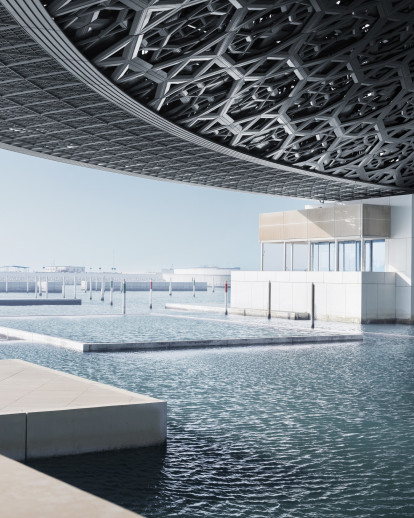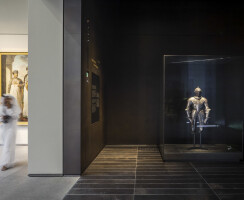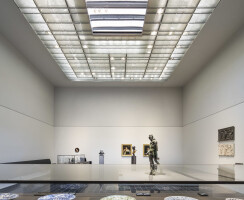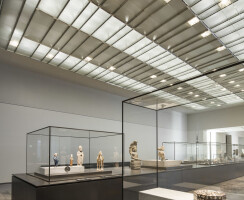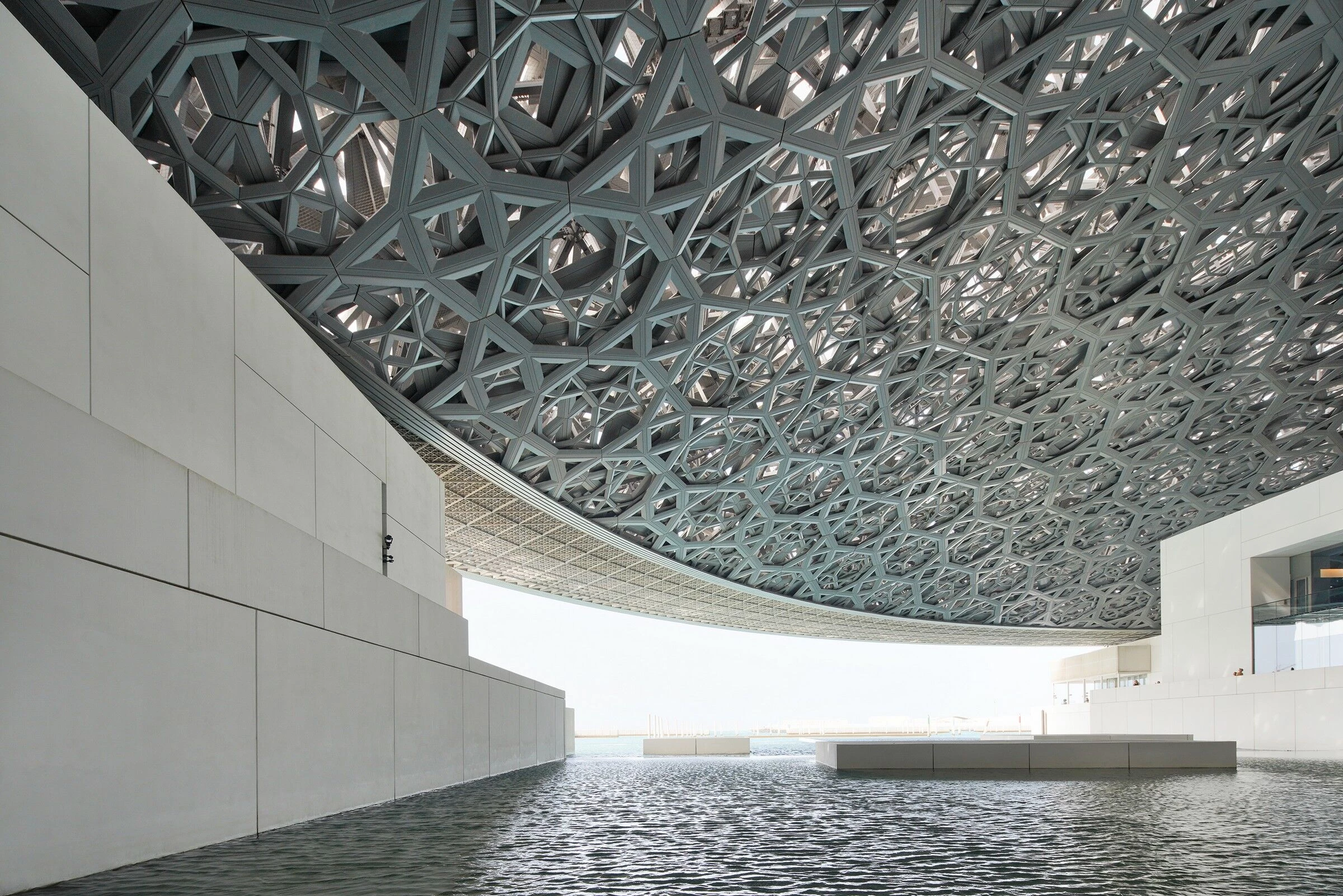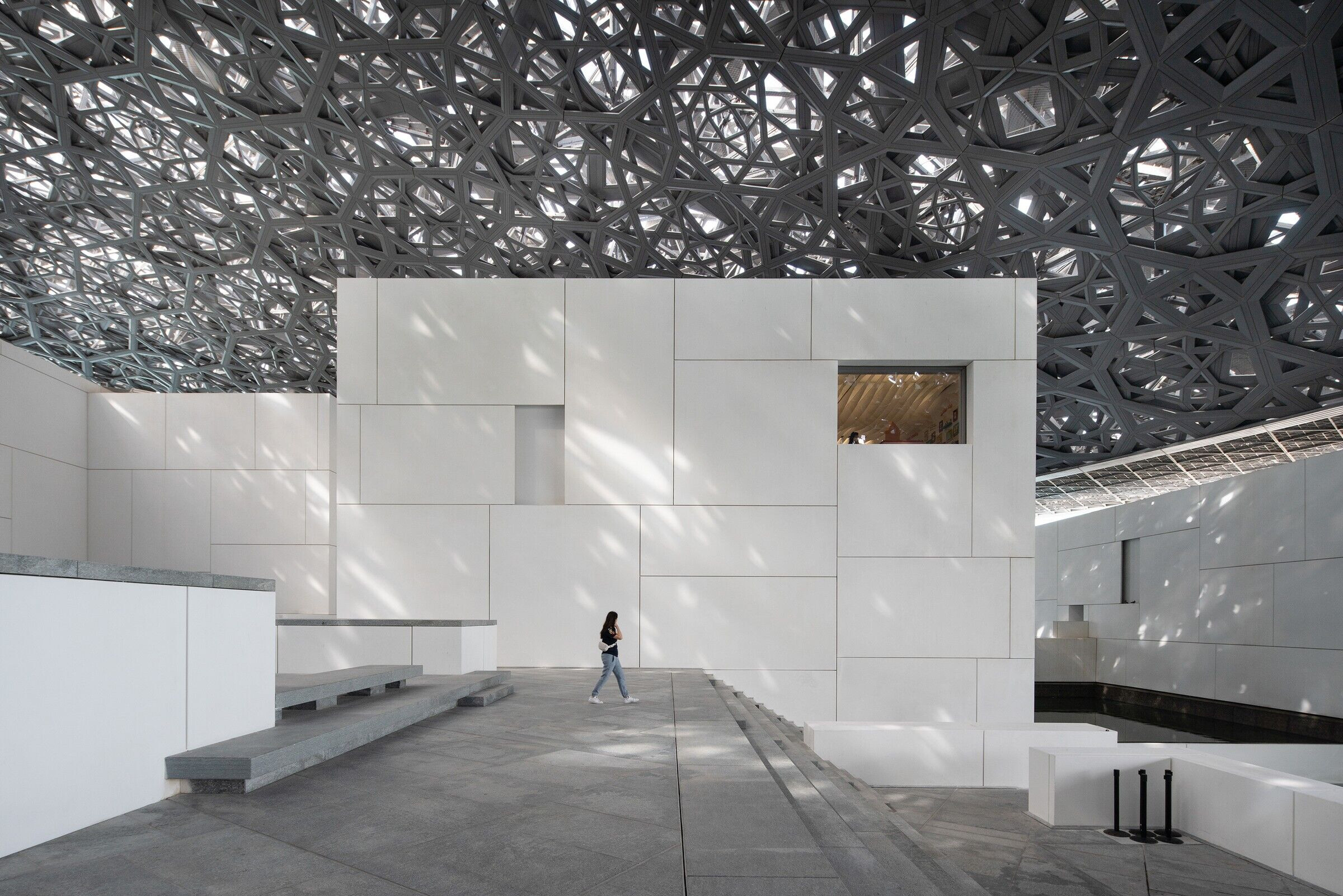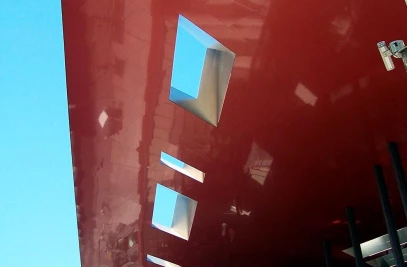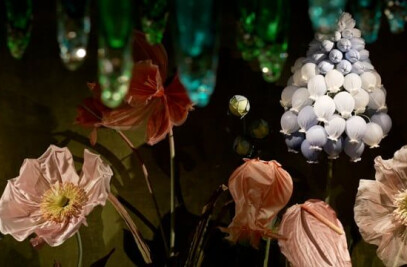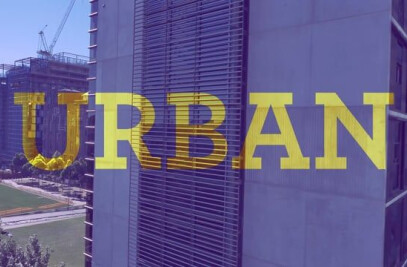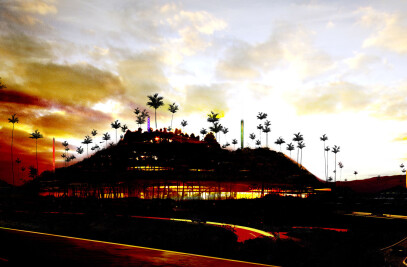Like the stars that guide the nomad in the desert, Jean Nouvel’s dome invites us to look up and contemplate our world. At the heart of the museum is a double dome 180 metres in diameter, offering horizontal, perfectly radiating geometry, along with a randomly perforated woven material, providing shade punctuated by bursts of sun. The dome gleams in the Abu Dhabi sunshine. At night, this protected landscape is an oasis of light under a starry dome.
More from the Engineers:
A unique cross-cultural collaboration
Louvre Abu Dhabi was born from a unique intergovernmental agreement between the United Arab Emirates and France, signed in 2007.
The agreement embodies a vision shared by France and Abu Dhabi to develop the first universal museum in the Arab world. It establishes Louvre Abu Dhabi as an independent institution, and includes the use of musée du Louvre’s name for 30 years and 6 months.
As per the intergovernmental agreement, Louvre Abu Dhabi has invaluable access to expertise and training from 17 French partner institutions, as well as loans from 13 leading French museums for 10 years. Additionally, these institutions will support with programming special exhibitions at Louvre Abu Dhabi for 15 years.
Through Agence France-Muséums (AFM), Louvre Abu Dhabi explores new approaches and bringstogether for the first time: musée du Louvre, Centre Pompidou, musée d'Orsay and musée de l'Orangerie, Bibliothèque Nationale de France, musée du quai Branly - Jacques Chirac, Réunion des Musées Nationaux et du Grand Palais, Chateau de Versailles, musée National des Arts Asiatiques-Guimet, musée de Cluny, Ecole du Louvre, musée Rodin, Domaine National de Chambord, musée des Arts Décoratifs de Paris, Cité de la Céramique - Sèvres & Limoges, musée d'Archéologie nationale - Saint-Germain en Laye, Château de Fontainebleau, and OPPIC (Operateur du patrimoine et des projets immobiliers de la culture).
Agence France-Muséums oversees the involvement of these partner institutions and provides direction for the curatorial and cultural programme, including guidance on creating the permanent collection, support for the temporary exhibitions and coordination of loans from partner museums. With around half of their team based in Abu Dhabi, AFM also provides Louvre Abu Dhabi with project management support during the museum’s construction, and input into its developing policies for visitors.
Curatorial statement: a universal museum in the era of globalisation
Like the stars that guide the nomad in the desert, Jean Nouvel’s dome invites us to look up and contemplate our world. At the intersection of mathematics and organic life, the dome delineates a realm unto itself, in which the space and time of the museum unfold. The dome also pays homage to the vital importance of shade in Arabia, and at the same time filters the light to create a kind of cosmic calligraphy of imaginary forms. Beauty is born from this adjacency of opposites.
Louvre Abu Dhabi is a universal museum, in our age of globalisation. The word “universal” derives from “unus,” or “one,” and “vertere,” or “to turn.” Does the world turn around a centre, just as the planets and the sun were long ago thought to turn around the Earth? Rather, we should understand this etymology in-versely—as a plurality that turns into unity, or as a striving for coherence. In that spirit—to demonstrate what humanity has in common—Louvre Abu Dhabi takes the path of universality.
The universal spirit is revealed in stages at the museum. Its galleries offer visitors a vast historical fresco of “the long and visible development of humanity,” as the French poet and writer Charles Péguy described an important attribute of a universal museum. This is illustrated at Louvre Abu Dhabi by works of art from around the world, from across eras and cultures, since the museum is blessed not only with a splendid collection but also with exceptional loans from French museums.
The succession of rooms thus becomes a narrative. After a prologue of masterpieces from multiple periods of time, an enigma prompts visitors to reflect on the meaning of universality. The majesty of the architecture animates this narrative, as do the individual galleries’ wall panels and digital elements. Everything is done to ensure that the visitors’ encounters with works of art give rise to emotions and questions.
The presentation of the works brings together cultures and civilisations in the same galleries, in explorations of the general spirit of their times. How else could we show the remarkable similarities between the Sumerian priest-kings and the pharaohs of Egypt, the reciprocal influences between China and the Islamic World, and the effects of the expansion of industrial civilisation? With the traditional partitioning of museum departments removed, we can see what the artefacts have to say in a different—and more universal—light. In the space of the museum, even in the space of a single display case, these dialogues establish new viewpoints and discoveries.
The shift in museum location, from Paris to Abu Dhabi, inevitably produces a shift in perspective. The concepts of Antiquity, the Middle Ages, the Renaissance and Modernity, which place the West at the centre of history, become relative with respect to the advances of the universal world. Louvre Abu Dhabi undertakes, for example, to reveal the mixed or hybrid nature of so-called Western “modernity.” If the civilisations of Africa, the Americas, Asia and Islam gradually came under the influence of Western representations after 1500, those representations had in turn been borrowed on a large scale from the rest of the world. Western modernity is reconsidered here in Abu Dhabi, above all in the light of what the British anthropologist Jack Goody called the “theft of history” perpetrated by the West, which believed itself to be “modern,” at the expense of other civilisations, which were supposedly not. This reading of events is crucial for Louvre Abu Dhabi, conceived in the 21st century in a part of the world that is seeking to increase its influence by taking its place in the illustrious memory of manifold legacies.
And it is indeed in the Arab-Muslim world of the 21st century that Louvre Abu Dhabi is embedded. This shift in focus, necessary to the goal of cultural reappropriation, also possesses a historical logic. With its long tradition of centrality and interrelations, the world in which the new museum is located is heir to a vast cultural entity in the heart of Eurasia. The birth of Louvre Abu Dhabi is also taking place at a particular moment in the history of the area, when the Arab world is reasserting its culture, a change in which Edward Said’s Orientalism has played a key part.
This dynamic calls for a different narrative of the world. The one presented to visitors at the end of 2017 takes into account this new context, which has been developed by a team with a multiplicity of perspectives. The child of a globalised world, Louvre Abu Dhabi is also the offspring of the contemporary cultural mainstream, with its constant alternation of de-territorialisation and relocation. Thus the destiny of Louvre Abu Dhabi will long be forged in the complex dialectic between asserted identity and universal openness.
- Jean-François Charnier, Scientific and Cultural Director of Agence France-Muséums
Architectural statement: The museum and the sea
“All climates like exceptions. Warmer when it is cold. Cooler in the tropics. People do not resist thermal shock well. Nor do works of art. Such elementary observations have influenced Louvre Abu Dhabi. It wishes to create a welcoming world serenely combining light and shadow, reflection and calm. It wishes to belong to a country, to its history, to its geography without becoming a flat translation, the pleonasm that results in boredom and convention. It also aims at emphasising the fascination generated by rare encounters.
It is rather unusual to find a built archipelago in the sea. It is even more uncommon to see that it is protected by a parasol creating a rain of light.
The possibility of accessing the museum by boat or finding a pontoon to reach it by foot from the shore is equally extraordinary, before being welcomed like a much-awaited visitor willing to see unique collections, linger in tempting bookstores, or taste local teas, coffees and delicacies.
It is both a calm and complex place. A contrast amongst a series of museums that cultivate their differences and their authenticities.
It is a project founded on a major symbol of Arab architecture: the dome. But here, with its evident shift from tradition, the dome is a modern proposal.
A double dome 180 metres in diameter, offering horizontal, perfectly radiating geometry, a randomly perforated woven material, providing shade punctuated by bursts of sun. The dome gleams in the Abu Dhabi sunshine. At night, this protected landscape is an oasis of light under a starry dome.
Louvre Abu Dhabi becomes the final destination of an urban promenade, a garden on the coast, a cool haven, a shelter of light during the day and evening, its aesthetic consistent with its role as a sanctuary for the most precious works of art.” - Jean Nouvel, architect of Louvre Abu Dhabi
Masterpieces of the universal narrative
Louvre Abu Dhabi’s collection
Presented across 6,400 square metres of galleries, the museum’s growing collection of exceptional treasures includes more than 620 important artworks and artefacts spanning the entirety of human history around the world. It includes ancient archaeological finds, decorative arts, neoclassical sculptures, paintings by modern masters and contemporary installations. At opening, 235 works from Louvre Abu Dhabi’s own collection are displayed in the galleries.
Louvre Abu Dhabi began acquiring works in 2009. Since then, some works have already been displayed as loans in eminent cultural institutions such as Centre Pompidou Metz, musée d’Orsay, National Gallery of Art in Washington D.C., Kimbell Art Museum, musée de l’armée and Fondation Yves Saint-Laurent Pierre Bergé.
Leading French museums lend major works
Louvre Abu Dhabi will present 300 significant works on loan from 13 leading French museums for the inaugural year. These include masterpieces representing civilisations and artistic movements from significant moments in global human history, including ancient Egypt, the Roman Empire, ancient Chinese dynasties, the Kingdom of Benin in present-day Nigeria, the Renaissance, the Impressionists and the Modernists. Many of these will be displayed in Abu Dhabi for the very first time, including Leonardo da Vinci’s seminal work La Belle Ferronnière, on loan from musée du Louvre.
French museum partners will lend artworks to Louvre Abu Dhabi for a period of 10 years, decreasing over time as the permanent collection grows.
Significant loans from the region
Louvre Abu Dhabi has partnered with important museums and cultural institutions in the Arab world who will lend 28 significant works.
The National Museum of Ras Al Khaimah provides objects including a pendant dating back to 2000-1800 BCE and a painted Neolithic vase discovered on Abu Dhabi’s 8000-year-old Marawah Island settlement. Al Ain National Museum lends an important fragment of stucco from an ancient church in Abu Dhabi’s Sir Bani Yas Island.
Highlights of loans from the region include: a prehistoric stone tool dating back to 350,000 BCE from the Saudi Commission for Tourism & National Heritage; a collection of over 400 silver Dirham coins from the National Museum – Sultanate of Oman; and the Ain Ghazal Statue, an 8000-year-old two-headed figure from Jordan’s Department of Antiquities.
The first of the Saadiyat Cultural District museums, Louvre Abu Dhabi will open with a display of artworks from the collections of Zayed National Museum and Guggenheim Abu Dhabi. Zayed National Museum lends a selection of calligraphic works on paper, including Ottoman scrolls containing important paintings, texts and letter forms. Louvre Abu Dhabi’s contemporary chapter features works from Guggenheim Abu Dhabi’s collection by renowned artists such Abdullah Al Saadi, Ibrahim El-Salahi and the late Hassan Sharif.
Louvre Abu Dhabi’s galleries
The narrative is organised into 12 chapters across the museum’s galleries.
The Great Vestibule
Through a series of ancient works, the Great Vestibule presents universal themes that highlight surprising similarities between early civilisations: gold death masks, maternity figures, water containers, writing instruments, precious reliquaries, decorative patterns featuring the sun, figures at prayer and horseriding. The similarities between the artworks are not explained, but are there to make visitors ask questions. It invites the visitors to walk into the galleries.
Gallery 1: The First Villages
It took millions of years for the human species to spread across the globe from its origins in East Africa. However, by 10,000 BCE, in the Near East, China and Central America, communities settled for the first time and domesticated animal and plant species, which led to the appearance of the first villages. Despite regional differences, the first village communities seem to have shared a desire to bind their community together, by means of beliefs and rituals around their ancestors. Human representation developed in the form of these female figurines that seem to express preoccupations with fertility. The wealth generated by profits from agriculture and livestock supported the birth of the first forms of power.
Gallery 2: The First Great Powers
The first kingdoms appeared in the fertile valleys of the Tigris, Euphrates, Nile, Indus and Yellow River around 3000 BCE. The emergence of these first great powers was accompanied by the spread of bronze weapons. Axes, swords and armour became emblems of prestige and splendour for the powerful. The new warrior elite also began to ride horses, a development that spurred long-distance exchanges, increased the size of kingdoms and broadened the horizons of communities.
With the development of the kingdoms of Mesopotamia and Egypt came the birthof the first cities, a crucial event in the history of humanity. Resulting from a population surge and a strong hierarchical organisation of society, the first cities became social and cultural melting pots that encouraged exchange and innovation. One fundamental invention was writing, which facilitated transactions and helped legitimise power.
Gallery 3: Civilisations and Empires
From about 1000 BCE, on most continents the first kingdoms gave way to vast cultural and political groups. The Assyrian and then Persian empires dominated the Middle East, while Greek cities became established around the Mediterranean basin. The Nok and Olmec cultures spread across West Africa and Mesoamerica respectively. The evolution, encounters and clashes of these empires stimulated artistic and philosophical fusions whose influences are still felt today.
After setting out from the Greek kingdom of Macedonia in 334 BCE, Alexander the Great forged an unprecedented political union between Europe and Asia, which led to the formation of immense empires. As Rome, in its heyday, expanded its domination over the whole Mediterranean region, the Han Empire was expanding enormously in China. The collapse of these empires led to a regeneration of artistic forms that would be used by universal religions to communicate their message.
Gallery 4: Universal Religions
Beginning around 2000 years ago, the spread of universal religions succeeded in reaching most of the civilised areas of Europe, Asia and Africa in just a few centuries. By addressing their message to all humanity without distinction, Buddhism, Christianity and Islam transcended local cultural characteristics and deeply transformed ancient societies.
These religions shared with Judaism the concept of monotheism but diverged on such subjects as the representation of the divine. Their expansion was sometimes conflictual and brought them into contact with other beliefs, such as Hinduism in Asia, Confucianism and Taoism in China, Shintoism in Japan, and Animism in Africa. Religion had by then become a factor that unites communities and exerts an influence on intellectual and artistic activities across continents.
Gallery 5: Asian Trade Routes
The expansion of universal religions occurred in parallel with the establishment of vast networks of exchange between continents. In Asia in the 7th century, China became the main actor in these exchanges and a major hub for innovation. The invention of porcelain, gunpowder, paper and printing characters was to change the world. China passed most of its inventions to the Arab-Muslim world along the land and sea routes used in the silk trade.
The Islamic civilisation lay at the heart of this thriving trade network linking Asia, Europe and Africa. From the 8th to 10th centuries, Baghdad witnessed a golden age of the arts and sciences. The caravan routes taken by merchants crossed the paths followed by pilgrims, and promoted the spread of new modes of thought. These exchanges boosted the circulation of exotic materials and luxury items like silk, ceramics, jewellery, incense or ivory.
Gallery 6: From the Mediterranean to the Atlantic
The Mediterranean basin was the culminating point of the commercial and cultural routes across Asia and Africa. From the 11th century, exchanges increased between the Byzantine Empire, the Islamic world and Christian Europe, in spite of their rivalries and conflicts. While the cities of Venice and Genoa took an active part in these exchanges, the Iberian Peninsula, divided between Islam and Christianity, became a site of rich cultural diversity.
In Europe, competition between Christian kingdoms and flourishing trade contributed to economic and scientific development. At the end of the 15th century, Portuguese navigators explored the coastline of Africa and opened new trade routes to the Indian Ocean. The crossing of the Atlantic and discovery of the American continent created contact between Europe and the Amerindian civilisations, which had until then remained isolated.
Intersection: Cosmography
Around 1500, for the first time since the beginning of humanity, man was able to travel all around the globe. Great navigators, such as Ibn Majid, Zheng He and Christopher Columbus, established direct contact between lands that up until then had remained remote or unknown to one another. Civilisations that had once traded on the grounds of geographical proximity gradually engaged in a system of exchanges on a global scale. The world witnessed an early form of globalisation.
Awareness of the magnitude of the world prompted questions about the meaning of the universe. Instruments used in navigation and cosmography developed rapidly. The first travelogues were published, recounting journeys to distant lands, while maps and globes charted the contours of this new world. The exotic materials and strangely-shaped works of art that filled “cabinets of curiosities” in Europe illustrated this fascination for distant and mysterious lands.
Gallery 7: The World in Perspective
Pioneering voyages broadened horizons and offered a new perspective of the world. Discoveries in the fields of mathematics and optics transmitted from the Arab world to Europe in the 15th century had important consequences for art. Forming the foundation of the geometric and abstract approach to representation in Islamic art, they also enabled European artists to create depth and three-dimensionality in images.
The flourishing intellectual and artistic activity of the time was called the Renaissance by Europeans who were rediscovering their Antiquity. For artists and architects, it provided an aesthetic model that profoundly renewed the representation of the human body and landscapes. In China, too, artists found inspiration in the models of the past to strengthen the cultural and political legitimacy of their monarchs. Meanwhile, the Arab-Islamic world developed an international style that placed emphasis on the use of geometric and floral forms.
Gallery 8: The Magnificence of the Court
Encounters between different worlds led to unprecedented rivalry between rulers. This phenomenon took on a new dimension in the 17th century and occurred simultaneously throughout Europe, China, the Muslim empires and the kingdoms of Africa. Sovereigns glorified themselves by displaying symbols of their power and commissioning majestic representations of their royal person and court. Equestrian portraits became a widespread form of representation.
Monarchs competed to attract the best artists, commission new decorative settings and invest enormous amounts in the construction of palaces and religious buildings of exceptional opulence. The magnificence of court life, the luxury of costumes and weaponry and the splendour of art collections gave rulers a dazzling image that was designed to overshadow other kingdoms and states.
Gallery 9: A New Art of Living
During the 18th century, the affluence enjoyed by monarchs was attained by an increasingly large segment of society. The spread of manufactured products around the globe progressively transformed economies and stimulated new modes of consumption. Greater attention was paid to the furnishing and decoration of houses and to clothing. In China, Japan and Europe more manufacturers offered goods to an increasing number of customers.
Across all continents, the arts reflected an increased emphasis on the private sphere, the individual and the family. With the growth in global exchanges, the arts developed an imaginative image of remote lands and cultures. Europe was increasingly pervaded by a philosophy of progress and reason referred to as the Enlightenment. This intellectual movement focused on the individual and their role in history, as illustrated by the American and French revolutions at the end of the century.
Gallery 10: A Modern World?
Economic competition between nations gave birth to the Industrial Revolution in Europe. Having been an instrument of Europe’s colonial enterprise, this revolution spread progressively to the rest of the world during the 19th century. The development of means of transport and colonisation impacted all civilisations, which, in return, provided European artists with inspiration.
Technical progress and artistic creation were glorified in universal exhibitions.
Photography, a product of industry, took on an important role in the art world. By capturing reality and eliminating distance, it gave the individual the impression of taking possession of the world. Since its invention, photography revolutionised artistic creation, prompting painters in Europe, then around the world, to drastically alter the way they capture images and translate the real world onto canvas.
Gallery 11: Challenging Modernity
During the 20th century the notions of modernity and progress, which the industrial and colonial West had spread across the planet, were brought into question. The two world wars and many instances of decolonisation challenged a great number of certainties. Artistic creation reflected these developments, experiencing constant reinvention, punctuated by divisions and radical movements such as abstraction, ready-mades and the imaginative universe of the Surrealists.
Echoing the remarkable pace of modern life, the rapid succession of artistic movements constantly opened new perspectives. The boundaries of art were continually redefined, extended and in constant transformation. The avant-garde movements in Paris and elsewhere in Europe attracted artists from all over the world. The growing influence of North American artists coincided with the broadening of artistic horizons to encompass the world as a whole.
Gallery 12: A Global Stage
At the beginning of the 21st century, the scale of communication around the globe seems to have transformed the planet into a global village. The fall of the Berlin Wall in 1989 marked the end of a historical era in which the West had occupied centre stage. The economic rise of most continents has given way to a multipolar and multicultural world in which artists have taken it upon themselves to invent a different version of modernity.
The instant spread and omnipresence of television and internet images place the representation of the world in a state of constant self-reflection. Creative works have become mirrors of our collective memory stirred by identity issues, the self as a narrative, as well as our concerns about our fragile planet. Artists continue to help us raise or put these existential questions in perspective, as they have done since the dawn of humanity.
Commissioning contemporary artists
Louvre Abu Dhabi invites renowned contemporary artists to create site-specific installations, inspired by the museum’s ethos, architecture and collections, as part of an ongoing commissions programme.
At opening, Louvre Abu Dhabi will present the first commissions, For Louvre Abu Dhabi by Jenny Holzer and Germination by Giuseppe Penone. Their monumental installations will be displayed under the museum’s dome in open air.
Giuseppe Penone and Jenny Holzer have worked closely with Louvre Abu Dhabi’s team and Jean Nouvel to develop sculptures and installations that integrate into the architecture and reflect the universal stories of the museum.
For Louvre Abu Dhabi (2017), limestone reliefs by Jenny Holzer
Jenny Holzer’s textual installations inscribe Louvre Abu Dhabi’s celebration of cross-cultural dialogue into the very walls of the museum. Holzer has selected three important historic texts from three distinct world traditions, and reinterpreted key passages in immense scale as engravings on the museum’s walls.
The content and aesthetics of the three texts are, individually and collectively, unusually well-suited to Louvre Abu Dhabi’s universal vision. Though they originate from different civilisations in different parts of the world, they each reveal an author grappling with essential truths about humanity and reflect on the origins of civilisation, the recording of history and the dynamics of cross-cultural exchange.
The oldest of the three texts is a Mesopotamian clay tablet which recounts a creation myth imagined almost 4000 years ago, telling the story of the creation of humans from blood and clay. Bilingual in Sumerian and Akkadian cuneiform scripts, it is an early example of the art of translation, which can be traced back to the birth of writing in Mesopotamia. Excavated from the ancient city of Assur in present-day Iraq, the clay tablet is part of the Vorderasiatisches Museum collection in Berlin, Germany.
From the MuqaddimahbyIbnKhaldun, Holzer reproduces three pages which explore the soul, spirit, music and language, and present a poetic ode to the art of calligraphy. In his text, IbnKhaldun (1332–1406), the father of modern historiography, considered how societies can understand their pasts, while producing a lively picture of humanity’s achievements in Islamic theology, philosophy, natural sciences, chemistry, alchemy and aesthetics. Dating from 1377 and written in Arabic, the Muqaddimah is part of the collection of the AtifEfendi Library in Istanbul.
The third source textis Michel de Montaigne’sLes Essais. Holzer has drawn on Montaigne’s own 1588 manuscript from the Bibliothèque de Bordeaux, which contains copious handwritten annotations supplementing the printed text. The selected pages, written in Old French, feature Montaigne’s revisions to three essays devoted to self-determination, the challenges of writing, the tasks of criticism and the celebration of poetry, and demonstrate his quest to understand the true nature of the world through discussion, dialogue and conversation. Les Essais is regarded as a bridge between ancient, Renaissance and modern thought.
Artist’s statement
“It's delightful to work on this significant new museum. Louvre Abu Dhabi sets an ambitious agenda for itself, and raises lively questions about museums and civilisations. It’s a privilege and a challenge to realise an installation that joins Jean Nouvel's architecture and that speaks with the fantastic works the museum will display. I made my walls in close relation to Jean Nouvel's building, which I saw as an ideal archaic village under a most beautiful futuristic sky dome.” – Jenny Holzer
Special exhibitions 2017 & 2018
Louvre Abu Dhabi will present four special exhibitions each year, curated and organised in collaboration with French partner institutions and Agence France-Muséums. This rich and diverse programme complements the permanent collection and enhances the museum’s universal narrative.
Special exhibitions in the first year will explore the history of Paris’ musée du Louvre; the representation of the world through spheres; early photography; and the decorative paintings of the Nabis group.
In addition to these exhibitions, Co-Lab: Contemporary Art and Savoirfaire will also be on display during the opening year.
From One Louvre to Another: Opening a Museum for Everyone
The inaugural special exhibition, From One Louvre to Another: Opening a Museum for Everyone, opens on 21 December 2017, and traces the history of musée du Louvre in Paris in the 18th century. Divided into three sections, the exhibition will look at the royal collections at Versailles under King Louis XIV; the residency of the Academy and Salons in the Louvre, converted into a palace for artists; and the creation of the musée du Louvre. It will feature approximately 150 significant paintings, sculptures, decorative arts and other pieces, mainly from the collections of musée du Louvre, but also from the Château de Versailles.
The exhibition is curated by Jean-Luc Martinez, President-Director, musée du Louvre, and Juliette Trey, Curator, Prints and Drawings Department, musée du Louvre.
Co-Lab: Contemporary Art and Savoirfaire
This is a collaborative project, a "skills workshop" that gave four UAE-based artists the opportunity to work with four premium historical French manufacturers. Carefully paired based on shared inspirations and complementary techniques, the Manufacture Nationale de Sèvres welcomed TalinHazbar to work on ceramics, the Manufacture de Beauvais opened up its art of weaving to Khalid Shafar, the Haute Verrerie d’art de Saint-Just collaborated with ZeinabAlhashemi and the MTX BroderieArchitecturale studios teamed up with VikramDivecha.
The process, initiated throughout an exchange programme, paired artistic research with the high standards of the historical French craftsmanship, traditionally open to the innovations of contemporary artists. This project focused on transmission and exchange. The temporary exhibition presents the final artworks, created by the artists and produced by the French manufacturers.
Co-Lab is part of the Emirati-French Cultural Programme: Dialogue with Louvre Abu Dhabi initiative established by the Department of Culture and Tourism – Abu Dhabi and France’s Ministry of Foreign Affairs and International Development, Ministry of Culture and Communication and the Institutfrançais.
The World in Spheres
The exhibition will explore the representation of the world from antiquity to the present day through a collection of important globes.
The first globes were produced in the 4th century BCE by the Greeks, but between the 8th and 15th centuries, Muslim astronomers were at the forefront of astronomic research, and created exquisite globes and astrolabes. 125 celestial globes from the Islamic world remain in existence today, with the oldest dating from the 11th century. This ancient science was passed through Muslim Spain in the 10th century and re-emerged in Europe as scientists began generally to accept the theory of a spherical Earth. Globes became both a tool for explorers to navigate the world and a means to tell stories about their new discoveries through artistic interpretations of the map. While navigational technology has improved beyond imagination, globes have continued to be household objects in various forms to the present day.
The World in Spheres will be curated by Catherin Hofmann, Chief Curator at BibliothèqueNationale de France and François Nawrocki, Chief Curator at the Bibliothèque Sainte-Geneviève.
Opening the Album of the World: Photographs, 1842-1896
This exhibition will look at early photographs produced using the first methods in different parts of the world, created by Western explorers as well as the very first local and international photographers.
Photography in its current form was invented around 1839, a period of discovery and colonial expansion. Photographers were sent out into the world on European ships to document the distant lands and peoples they encountered. Drawing on the collections of the musée du quaiBranly – Jacques Chirac and other institutions, the exhibition travels from continent to continent through a selection of photographs produced between 1842 and 1895 by various practitioners. It includes many images captured by international photographers appropriating this new technology for their own ends, including Colombian, Turkish, Indian, Brazilian, Egyptian, Chinese, Japanese and Russian photographers, and a variety of different photographic formats, from daguerreotypes to travel albums.
The exhibition will also present the first images of the Arabian Gulf region: 1850s photographs of Yemen, and an image of the Hejaz from 1861.
It will be curated by Christine Barthe, Curator, Head of the Photographic Collection at musée du quaiBranly – Jacques Chirac.
The Nabis and modern decoration: An East-West dialogue
Louvre Abu Dhabi’s fourth special exhibition will present around 30 remarkable decorative paintings from the group of artists known as the Nabis, from the collection of musee d’Orsay, alongside a number of Japanese prints and folding screens from muséeGuimet and Louvre Abu Dhabi. It will highlight the dialogue between Eastern and Western traditions and will demonstrate the fundamental contribution made by the Far Eastern aesthetic to the development of modern decoration.
Active in France between 1888 and 1900, the Nabis hoped to break down the barriers between different artist genres, and embraced decorative painting and scenery-making for stage productions. Core members of the group were particularly influenced by Japanese ukiyo-e, and the exhibition will include four sections illustrating the aesthetic principles espoused by the Nabis through their paintings in dialogue with Japanese art.
The exhibition will be curated by Isabelle Cahn, Chief Curator for paintings at musée d’Orsay.
Developing an audience of museum visitors
Since 2009, Louvre Abu Dhabi and other Saadiyat Cultural District museums have organised a variety of programmes, including, talks, workshops, concerts and exhibitions, to engage local audiences of different backgrounds and ages.
These programmes offered an opportunity to showcase the collections, test forthcoming visitor experience tools and develop a growing audience of enthusiastic visitors.
To date, Louvre Abu Dhabi has delivered four exhibitions:
Talking Art: Louvre Abu Dhabi (2009), a preview of 19 works acquired for the permanent collection, including two canvases by EdouardManet; a Chinese white marble Buddha head, 550-577 CE; a 16th-century Venetian ewer; and a 1480s Madonna and Child by Giovanni Bellini
Birth of a Museum, held in Abu Dhabi (2013) and Paris (2014), which unveiled a selection of 130 works from the permanent collection in Abu Dhabi and 160 in Paris, including a lion-shaped gold bracelet made in Iran nearly 3000 years ago; a fibula (brooch) in gold with garnets from Italy dating from the fifth century CE; paintings by Jordaens, Manet, and Magritte; a papiercollé by Picasso; and nine paintings by Cy Twombly
Louvre Abu Dhabi Stories (2015), a display in two parts linked by the Portrait of Fayoum, an ancient Egyptian funerary painting
Al Qalam – Arabic for ‘the pen’ – explored the art and development of the written word through a selection of texts including a Qur’an bifolio, miniatures and a manuscript
Immortal Figures featured sculptures from diverse cultures, including an 18th- or 19th-century Papua New Guinean wooden statue, a Nepalese gilt copper Buddhist figure, and an Italian bust of Saint Peter Martyr dating to 1490
To date, Louvre Abu Dhabi has staged over 50 talks, many as part of the Louvre Abu Dhabi Talking Art Series. This recurring discussion platform explored the museum’s themes and ideas through the collections, and covered topics including:
Light as a symbol of religion and philosophy, as interpreted through a 14th-century mosque lamp on loan from musée du Louvre in Paris
Louvre Abu Dhabi’s collection of Indian miniature paintings, acquired from film director James Ivory
Collages and ready-mades in modern art, which took Picasso’s Portrait of a Lady as a starting point
Rethinking Islamic art in new museums, presented as part of the 2015 Abu Dhabi Art programme
Over the past years, Louvre Abu Dhabi has also run more than 80 workshops for families and young people as part of the museum’s continuing education and engagement programme.
Louvre Abu Dhabi Art Club
The Louvre Abu Dhabi Art Club membership programme offers guests a range of exclusive benefits as well as the chance to become part of a vibrant cultural community.
Throughout the year, there will be special opportunities for members and their families to enjoy exclusive enhanced experiences, events and activities, such as first previews of the museum’s special exhibitions.
Art Club members can visit and revisit Louvre Abu Dhabi, discovering something new every time. Members and their guests can also enter the Musée du Louvre in Paris, and other partner museums, at no charge.
Members also receive priority booking and preferential prices for auditorium events, activities, workshops and guided tours, as well as a 15% discount at the museum café, which offers beautiful views over the Abu Dhabi waterfront.
Twelve-month options include a Member+1 package, with unlimited free access for a member and one guest (450 AED), or Member+5, which includes up to five named guests (1500 AED).
Inspiring the next generation
Louvre Abu Dhabi is a place of discovery and learning, open to everyone.
The museum welcomes children, families and young audiences, and provides the tools and opportunities for all visitors to explore the collections.
Developing the nation’s youth into highly educated critical thinkers is central to the UAE’s investment in the future. Louvre Abu Dhabi’s approach prompts audiences – including children, teenagers and young adults – to look closely and think deeply about the artworks on display and the wider cultures and ideas they represent.
The museum has already had a significant impact on the UAE’s educational landscape, and continues to offer training and opportunities to support an emerging generation of enthusiasts and museum professionals.
The Children’s Museum: A special place for families
Guests aged 13 and younger can enjoy unlimited complimentary entry to Louvre Abu Dhabi.
The Children’s Museum at Louvre Abu Dhabi is an exploratory space providing the opportunity to engage with artworks from the museum’s collection to young visitors (aged 6-12) and their families.
It presents its own special exhibitions, with artworks displayed in specially designed cases at children’s eye level and interactive mediation tools. With a range of immersive and interactive zones, the Children’s Museum offers a programme of hands-on activities and educational workshops.
The inaugural exhibition in the Children’s Museum is Travelling Shapes and Colours. It explores shapes and colours, such as floral and geometric ornamentation, through a selection of works from artistic traditions across the globe, including 16th-century Turkish ceramics, 18th-century decorative French vases and a 19th-century painting by German artist Paul Klee.
Travelling Shapes and Colours will remain on view until November 2018.
Family workshops
Louvre Abu Dhabi’s initiatives for children and families include an ongoing programme of tours, workshops and interactive sessions, inviting young visitors to explore Louvre Abu Dhabi through activities such as calligraphy, mask-making and visual storytelling.
Run by expert staff at Louvre Abu Dhabi, these activities encourage children to learn about and try out a range of artistic methods, practices and concepts at age-appropriate levels.
Children’s workshops 15 November to 31 December 2017
Workshops in the Children’s Museum (aged 6 and upwards)
· Geometric Patterns – 90 minutes (families)
Fridays 17:00 to 18:30
Identify all the different shapes in the artwork exhibited in the Children’s Museum. Back in the workshop, explore making different geometric patterns inspired by Islamic motifs before designing your own unique pattern.
· Make a Kaleidoscope – 90 minutes (families)
Saturdays 14.30 to 16:00
Explore all the different colours in the artworks displayed in the Children’s Museum. Back in the workshop, play with colour and together build a kaleidoscope to invent new patterns.
Workshops including gallery interaction
· Visual Storytelling – 90 minutes (families)
Saturdays 11:00 to 12:30
Explore a range of artworks from different cultures and discover how artists communicated their stories centuries ago. After the tour of the galleries, devise a story inspired by the collection and work together to create a comic strip that shares your message with the world.
· Calligraphy Decorations – 90 minutes (families)
Fridays 11:00 to 12:30 and Saturdays at 14:30 to 16:00
Explore how calligraphy is integrated into architecture and everyday objects. In the workshop, use galam and paintbrushes to work together as a family to decorate an object with your own special story inspired by your visit to Louvre Abu Dhabi.
Workshops for children and teenagers
· Architecture (ages 9 to 13 years)
Thursdays 17:00 to 18:30; Saturdays 17:00 to 18:30
Discover the architecture and the natural elements that inspired Jean Nouvel’s modern interpretation of the traditional dome and museum. Observe how the complex geometric shapes radiate an oasis of light across the site. In the workshop, investigate how the architect created the dome by working together to reproduce a large-scale model of Louvre Abu Dhabi.
· Put on your mask! (ages 8 to 12 years)
Wednesdays 17:00 to 18:30; Fridays 17:00 to 18:30
Investigate two masks in the Louvre Abu Dhabi collection and unearth how masks were used in different civilisations. Discover how human and animal forms inspired the design of these spectacular masks. Back in the workshop, use your research to create a mask using an assortment of 3D materials.
Schools
Since its inception, Louvre Abu Dhabi has worked closely with schools, universities and Abu Dhabi’s Department of Education and Knowledge to develop a range of resources suitable for students of all ages, integrate the museum into the national curriculum and inspire students to explore fields such art history, archaeology, anthropology and museum studies.
Louvre Abu Dhabi provides a range of resources for educators, including guides to significant artworks which offer question prompts to engage students and ideas for interactive classroom activities. The materials are available for school tour groups and classroom teaching.
During its opening week, Louvre Abu Dhabi will launch an educational portfolio for teachers from primary to secondary levels. This includes detailed descriptions of Louvre Abu Dhabi artworks linked to elements of school curricula, with observation prompts, discussion guides and hands-on activities appropriate for students from Kindergarten to Grade 12. The activities are designed to promote a thought-provoking and imaginative approach to art, the pleasure of discovery and the importance of students’ own views and ideas.
Higher education
Since Louvre Abu Dhabi was announced, the UAE has witnessed a significant increase in the number of undergraduate and postgraduate degrees available in related subjects, including New York University Abu Dhabi’s art history major, which offers a Museum and Cultural Heritage Studies track; a Master’s degree in History of Art and Museum Studies at Paris-Sorbonne University Abu Dhabi; and a Master’s in Museum Studies at Zayed University in Abu Dhabi.
Louvre Abu Dhabi works with these and other programmes to share resources, offer internships and encourage students to enter careers in the cultural and creative industries.
Now in its second edition, Emirati students from all fields have participated in Louvre Abu Dhabi’s Student Ambassador Programme, which trains and empowers young Emiratis to become skilled ambassadors for the project among their communities.
Professional development
Supporting the development of the UAE’s next generation of cultural professionals is a central pillar of Louvre Abu Dhabi’s mandate. The UAE’s cultural sector is evolving rapidly, and by building a skilled workforce of talented museum professionals, Louvre Abu Dhabi contributes to its continued growth.
Since the project was initiated, Louvre Abu Dhabi has invested in world-class training and work placements at French partner museums to develop its staff. Today 66% of the museum’s team are UAE nationals, including curators, conservators, researchers and education specialists.
